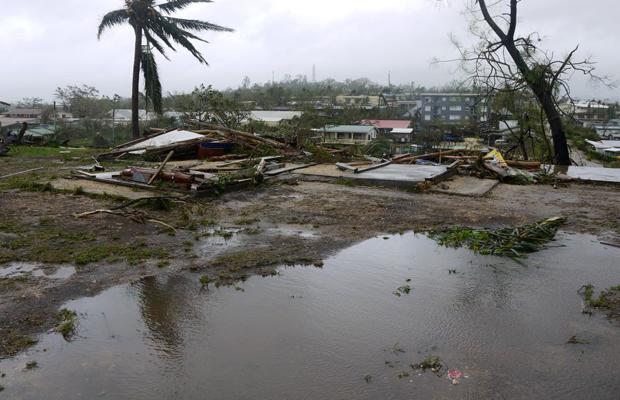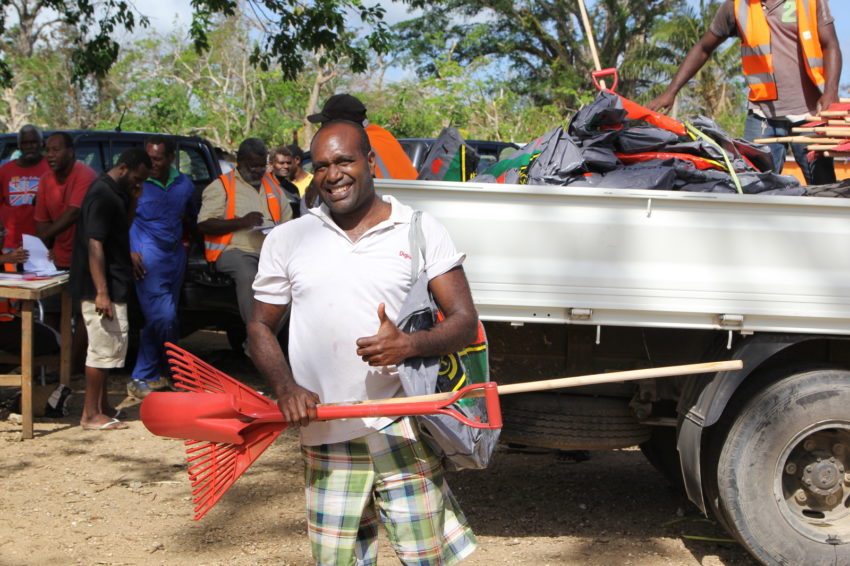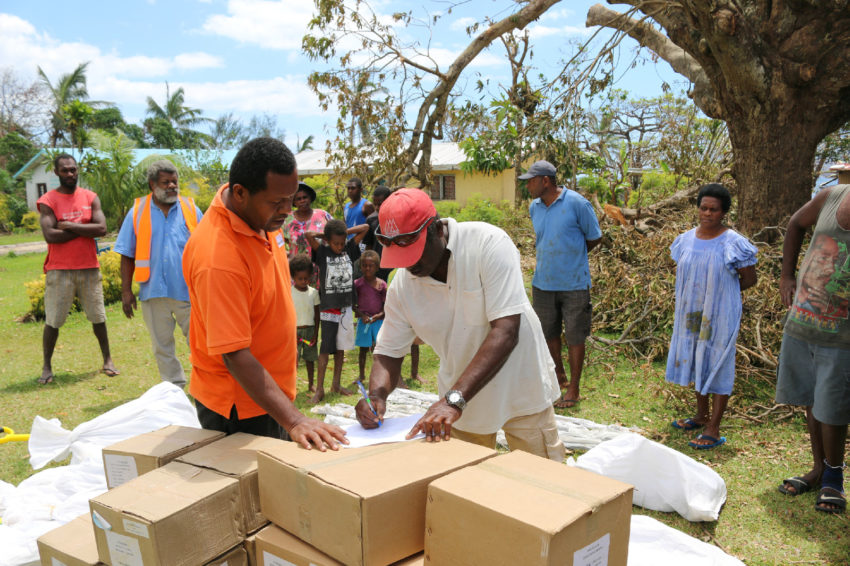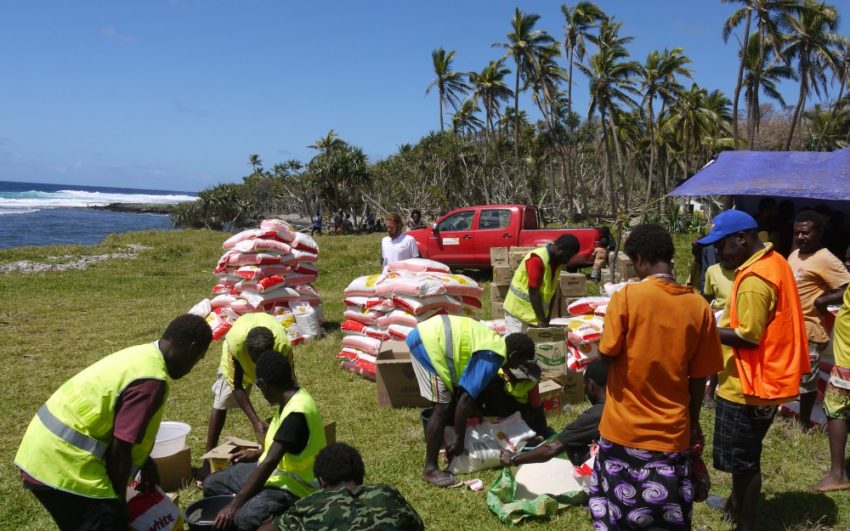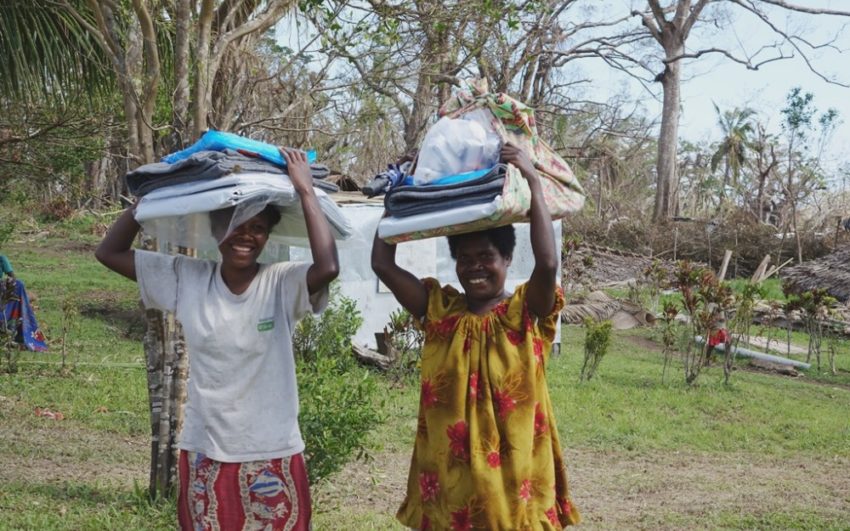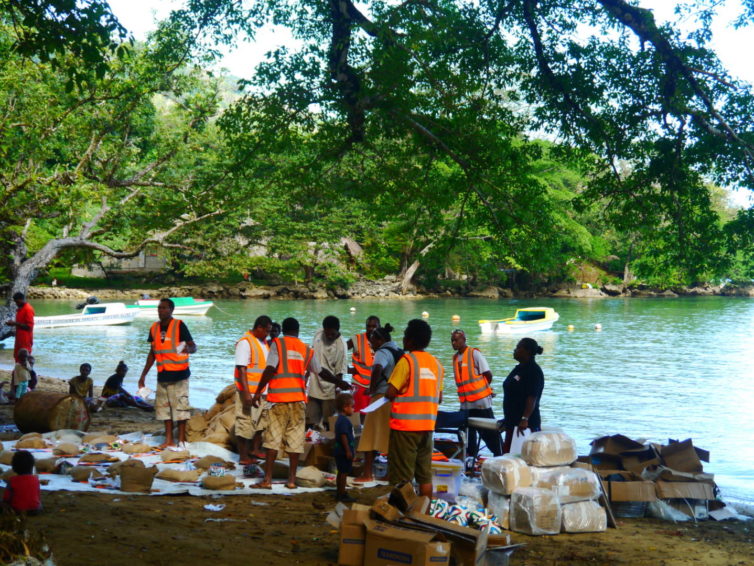On March 13, 2015, Cyclone Pam struck Vanuatu, an archipelago of more than 80 islands in the South Pacific that is home to about 270,000 people. The eye of the Category 5 cyclone passed close to Efate Island, where the capital Port Vila is located, with sustained winds up to 160 miles per hour. Overall, the storm affected 188,000 people — more than half of the national population — and all six provinces.
Southernmost provinces Tafea and Shefa were hardest hit, with 50–90% of shelters destroyed. Most families in Vanuatu live in rural, agricultural communities with homes made of wood and mud that are very vulnerable to storms and flooding. Because of early warning, most people had time to seek safe shelter, keeping the death toll low at 11, though food stocks, water sources, and crops were damaged, leaving communities hungry and vulnerable.
Cyclone Pam timeline
In early March 2015, a southward tracking tropical disturbance intensified northeast of the Solomon Islands until it became a powerful tropical cyclone.
2015 — Vanuatu is storm-struck
- March 9: Cyclone Pam becomes the third tropical cyclone of the 2014 to 2015 season.
- March 10 and 11: Vanuatu’s disaster management authority issues storm warnings and notifications of evacuation sites.
- March 12: Tropical Cyclone Pam reaches its peak strength as a Category 5 storm.
- March 13 and 14: Pam’s sustained winds reach 160 mph as it moves over Vanuatu’s islands and begins to weaken.
- March 15: Cyclone Pam passes northeast of New Zealand continuing to dissipate.
- March 16: The Vanuatu government makes a formal appeal for international emergency aid.
- October through December: The El Niño drought caused hardships for families and communities that lost rainwater harvesting structures during the cyclone.
2016 to 2018 — Recovery and rebuilding
- 2016 to 2017: El Niño effects continue, drying up rivers, destroying crops, and worsening hunger and malnutrition.
- March 12, 2017: Head of Vanuatu disaster management office, Shadrack Welegtabit, says full recovery will take two more years of work.
FAQs: What you need to know about Cyclone Pam and Vanuatu
Explore frequently asked questions about Vanuatu and Cyclone Pam, and learn how you can help people affected by disasters:
- Fast facts: Cyclone Pam in Vanuatu
- Where is Vanuatu? Tell me more about it.
- Is Vanuatu at high risk for natural disasters?
- Why did such a forceful storm cause only 11 deaths in Vanuatu?
- How can I help people affected by disasters?
Fast facts: Cyclone Pam in Vanuatu
- Cyclone Pam struck Vanuatu as a Category 5 storm on March 13 and 14, 2015.
- Pam was one of the worst Pacific Ocean storms in history.
- About 188,000 people were affected out of a total population of 270,000.
- Food stocks and water sources were damaged or destroyed; 95% of crops in affected areas were wiped out.
- Winds and water damaged or destroyed more than 70% of health facilities and 50% of schools.
Where is Vanuatu? Tell me more about it.
Vanuatu, formerly called New Hebrides, is an archipelago spread over 80 islands located in the South Pacific Ocean 1,000 miles east of Australia. About 270,000 people reside in Vanuatu, and the average per capita income is $3,130.
Is Vanuatu at high risk for natural disasters?
Vanuatu is vulnerable to frequent tropical storms, as well as earthquakes, volcanoes, and tsunamis. Many areas of the country are low-lying and prone to coastal flooding. Because Vanuatu is small, when a tropical storm or other disaster hits, it will very likely affect the whole country, including the capital and seat of government, Port Vila. Difficulties in transportation and communication between islands and in rural areas make it hard to recover from disasters.
Every year, 64% of Vanuatu’s population is exposed to natural hazards. Families dependent on subsistence agriculture for their food supply, and the 10% of the population in extreme poverty are especially vulnerable to shocks like cyclones. Cyclone Pam, for example, destroyed not only crops in the field that families needed for food, it destroyed banana and coconut plantations that were a vital source of income.
The United Nations University’s Institute for Environment and Human Security has ranked Vanuatu as the country most at-risk for natural hazards four years in a row in its annual World Risk Index.
Why did such a forceful storm cause only 11 deaths in Vanuatu?
Vanuatu’s early warning system was activated so text and media messages went out in time for the public to evacuate and assist their neighbors in reaching designated shelters that had been stocked with relief goods and prepared to accommodate them. Since most of the population lives in tight-knit, rural communities and are familiar with the natural hazards of the island home, people were able to hunker down in shelters prior to Cyclone Pam’s 160-mph winds hitting the islands.
How can I help people affected by disasters?
- Pray: Join us in prayer for children and families in Vanuatu and other countries in the Asia-Pacific region where communities are affected by poverty and recurring disasters.
- Donate: Give to World Vision’s disaster relief fund. Your gift will help us respond quickly and effectively to life-threatening emergencies across the globe and in the United States.
World Vision’s work in Vanuatu
World Vision began working in Vanuatu in the early 1980s with education, training, and income-generating projects. We have since expanded to include water, sanitation, and hygiene (WASH); agriculture; economic empowerment; education; early childhood development; and disaster risk reduction and preparedness. Today, we work in the four provinces of Tafea, Sanma, Efate, and Penama.
Early March 2015:
World helped communities prepare for Cyclone Pam by:
- Pre-positioning water, food, blankets, tarpaulins, and shelter, hygiene, and kitchen kits
- Warning communities about the coming cyclone and how to prepare, including the best places to shelter
- Providing disaster-preparedness training sessions that include planning emergency evacuations, and search and rescue techniques
World Vision staff communicator Chloe Morrison reported days before the storm, “Our World Vision staff has been amazing — visiting communities to warn them of the cyclone, helping families to protect their houses, and informing villages at risk of where evacuation centers are — all while preparing their own families and homes for what is on track to be Vanuatu’s most devastating cyclone in almost 30 years.”
March 13 through 16:
- World Vision began distribution of pre-positioned kits, including shelter materials, hygiene supplies, and kitchen/cooking sets to more than 800 people on March 14.
- World Vision participated in a joint rapid assessment coordinated by the government to gather preliminary data across the country, then conducted a detailed needs assessment in 16 communities on Pentecost, Efate, Erromango, and Tanna islands. World Vision was the first relief organization to reach Tanna Island, on March 16, with basic food supplies and water.
After one month:
- World Vision had delivered aid to 10,000 persons.
- With the Ministry of Health and World Health Organization (WHO), we coordinated measles vaccinations for more than 6,000 children.
After three months:
- World Vision had served 30,000 people in three provinces.
- Relief activities have included rehabilitating water systems that had been damaged, building ventilated improved pit toilets to improve hygiene, raising awareness about gender-based violence in crisis situations, distributing back-to-school kits for 150 schools, and assisting unaffected provinces to transport seedlings, cuttings, and root crops to affected provinces.
After six months:
- World Vision had assisted 55,000 people with food and household items.
- On Tanna island, one of the worst affected, World Vision handled delivery of emergency food aid, seeds, tools, soap, diapers, cooking pots, spades, and tarpaulins.
- On Erromango island, World Vision rebuilt traditional communal kitchens, but with better ventilation to reduce respiratory infections.
- On Pentecost and Tanna islands, World Vision teams repaired latrines, rehabilitated water sources, and delivered water tanks to schools whose access to water was damaged.
- On Malo Island, World Vision delivered water filters to 600 households.
- From November 2015 to July 2016, World Vision’s Urban Nutrition Center provided nearly 29,000 free meals to close to 1,900 vulnerable people who didn’t have enough food. We also worked with local organizations and the WHO to deliver food, nutrition training, and develop community gardens.
After one year, World Vision had:
- Assisted 62,000 people in three provinces with essential aid
- Delivered food to more than 55,000 people
- Handed out more than 47,000 essential household items
- Helped 23 communities restore clean water
- Delivered supplies to more than 80 preschools and primary schools
